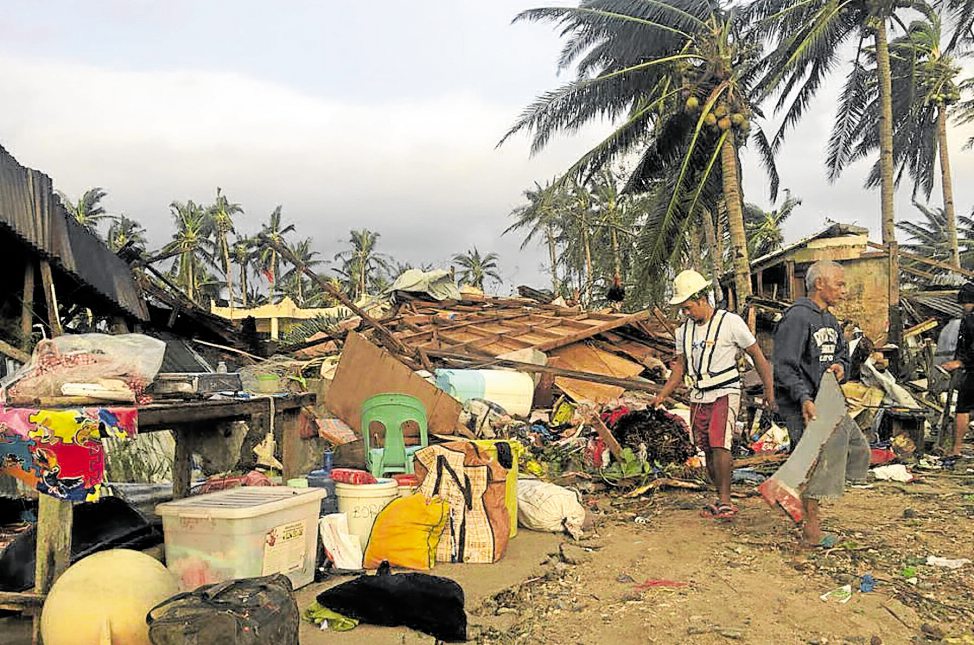Typhoon Ursula survivors appeal for help

SALVAGE MISSION Residents of Hernani, Eastern Samar, recover whatever materials are left from their houses for rebuilding, days after Typhoon “Ursula” hit their town. —LOURIEN MADARA
TACLOBAN CITY—Rodel Lucero and his family have been surviving on food provided by his friends since they lost everything to Typhoon Ursula (international name: Phanfone) on Christmas Eve.
Once his friends stop this act of charity, he would not know what to feed his wife and their 8-year-old daughter, said Lucero, 35.
“We lost everything,” he said. “Our house was washed out during the storm surge. I even lost the P3,000 that I had been saving for our New Year celebration.”
The storm surge swept through 30 houses, including Lucero’s, at Barangay 66 in Anibong District on Dec. 24.
A job-order employee at City Hall, Lucero said he, his wife and their child escaped with only the clothes on their backs. He said he was grateful for the help extended by his coworkers, without which he and his family would have nothing to eat.
Lucero said he had been scavenging for materials to rebuild his house so that they could take shelter from intermittent rains.
But the family also needs clothes, especially for the child.Other survivors of Ursula in Eastern and Western Visayas and in northern Cebu are also in need of food, clothes and building materials to reconstruct their homes.
Donation campaign
Bishop Crispin Varquez has issued a circular directing all priests in the Diocese of Borongan to conduct a donation campaign to help the survivors.
“Together, let us entrust to Our Lady, the patroness of our diocese, all our own spiritual and material needs, as we also include in our prayers and act of mercy those outside the diocese who were affected by the recent calamity,” Varquez said.
Ryan Ayon, of Hernani town in Eastern Samar, sounded a plea in behalf of his family and their neighbors in the coastal Barangay Carmen for housing materials, even tarpaulins, aside from basic necessities, such as food and clothing.
Ayon, an employee of the Tacloban City government, said he went home on Dec. 26 to check on his family. “Our village looks pitiful. Several houses were destroyed or damaged. Four houses in Sitio Tagudtud were washed out by the storm surge,” he said, adding that his own house was now roofless because of the typhoon.
Many residents of the village are unable to repair their houses for lack of money, Ayon said.
He said even the roof of Pedro E. Candido Memorial National High School was blown away at the height of the typhoon.
And since almost all the coconut trees in Carmen had been uprooted, Ayon said, he expected his neighbors to be financially affected because they all depended on the copra trade.
Aboy Abayan, 30, from Lawaan town also in Eastern Samar, echoed the need for basic commodities in their community.
Power supplyA public school teacher, Abayan said his house was rendered roofless and flooded with water and mud that destroyed appliances, books and important documents.
He said his community needed immediate assistance in terms of food and drinking water, medicines, clothing and housing materials.
In many parts of Eastern Samar, the typhoon survivors expressed hope that the power supply and communication signals would be restored soon to enable them to reach out to their relatives and seek help.
Generator sets were in high demand in the capital town of Kalibo in Aklan as the entire province remained without electricity and communication lines.
More than 2,000 families were homeless, according to initial reports reaching the Provincial Disaster Risk Reduction Management Office (PDRRMO) in Kalibo.
PDRRMO executive officer Galo Ibardolaza said it would take at least three days more to partially restore electricity in Kalibo and longer for the entire province.
Around 100 electric and transmission posts of Aklan Electric Cooperative and National Grid Corp. of the Philippines were toppled or damaged by Ursula’s strong winds.
Ibardolaza also said galvanized iron sheets were now in short supply as residents were beginning to repair their houses. He said that as of 10 a.m. yesterday, destroyed and damaged houses had tallied 2,460 and 17,881, respectively.
Among the worst hit was the northern town of Ibajay, where severe flooding was experienced even in the town center.
As many as 827 houses were destroyed and 7,899 others were damaged, according to a report of the Municipal Disaster Risk Reduction Management Office.
Severe flooding
In Capiz, fallen trees, electric posts and wires littered the national highway and some streets in Roxas City and adjoining towns.
Some farmers had to use small boats to cross flooded rice paddies.
Judy Grace Pelaez, executive officer of Capiz PDRRMO, said the floodwaters were not expected to recede until after several more days.
Angelo Orinse, whose house at Barangay Culasi in Roxas City was destroyed, said his community urgently needed food and drinking water.
Evacuees in Culasi were concerned that they had to leave the school when classes resume on Jan. 7, 2020. They expressed hope that government assistance, especially in rebuilding their houses, would be quicker than in the aftermath of Supertyphoon “Yolanda,” when many survivors had to wait for months.
“We hope help will come soon. We need it now,” Orinse said. —WITH A REPORT FROM NESTLE SEMILLA